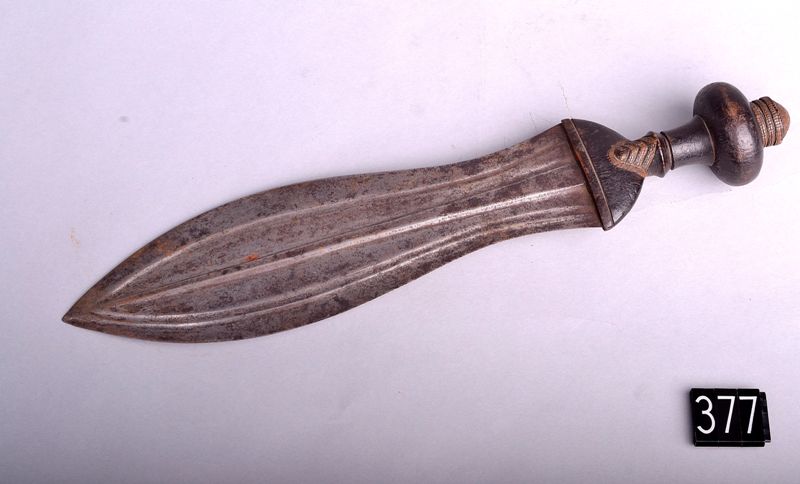Faịlụ:Raccolte Extraeuropee - Passaré 00377 - Pugnale Kuba - Rep.Dem.Congo.jpg
Raccolte_Extraeuropee_-_Passaré_00377_-_Pugnale_Kuba_-_Rep.Dem.Congo.jpg (800 × 484 pixel, ívù akwukwo orunótu: 63 KB, MIME nke: image/jpeg)
Failụ a si na Wikimedia Commons,enwekwara ike iji ya eme ihe na arụmarụ ọzọ. Nkọwa na ihuakwukwọ nkọwa failụ eziri na okpuru.
Mmẹkụwátá
| Italiano: Repubblica Democratica del Congo. Pugnale Kuba.
( |
||||||||||||||||||||||||
|---|---|---|---|---|---|---|---|---|---|---|---|---|---|---|---|---|---|---|---|---|---|---|---|---|
| Title |
Italiano: Repubblica Democratica del Congo. Pugnale Kuba. |
|||||||||||||||||||||||
| Nkówá |
Italiano: PUGNALE - Larga lama in ferro con medio in rilievo e scanalature laterali che riprendono la curva del filo della lama; elsa in legno con decorazioni in rame.
Secondo la tradizione (Vansina 1978) il coltello cerimoniale ikul sarebbe stato introdotto da Shyaam a cui i Kuba fanno risalire la fondazione della cultura e del regno kuba; ve lo avrebbe portato (XVII secolo), insieme ad altri oggetti culturali (tra cui il ricamo dei tessuti in rafia), dopo un viaggio presso le popolazioni dei Lele, dei Ding e dei Pende. |
|||||||||||||||||||||||
| Dimensions |
Ogo Ogologo: 37 cm dimensions QS:P2048,37U174728 |
|||||||||||||||||||||||
| Nchịkọta |
institution QS:P195,Q3928496 |
|||||||||||||||||||||||
| Accession number |
Passaré 00377 |
|||||||||||||||||||||||
| Object history |
|
|||||||||||||||||||||||
| Notes | Ivan Bargna (author of source for first revision), Carolina Orsini (scientific director) | |||||||||||||||||||||||
| References |
|
|||||||||||||||||||||||
| Source/Photographer | Raccolte Extraeuropee del Castello Sforzesco | |||||||||||||||||||||||
Nkwényé
- I wepulara nóru:
- i nye – ikọpị,ikekasi na izịpụ ọru a
- i dowaria – igbanwee ọrụ a
- Ọ ga bụ na ọnọdụ ndi a:
- í-kpó-áhà – Ị ga-enyerịrị ugo kwesịrị ekwesị, nye njikọ na ikikere ahụ, ma gosikwa ma emere mgbanwe. Ị nwere ike ime ya n'ụzọ ezi uche ọ bụla, mana ọ bụghị n'ụzọ ọ bụla na-egosi na onye nyere ikikere kwadoro gị maọbụ ojiji gị.
- gbásàa kà – Ọ bụrụ na ị tụgharịgharịa, gbanwee, ma ọ bụ wulite n'elu ihe ahụ, ị ga-ekesa ndenye gị n'okpuru otu ma ọ bụ ikike dakọtara dị ka nke mbụ.
|
This work is free and may be used by anyone for any purpose. If you wish to use this content, you do not need to request permission as long as you follow any licensing requirements mentioned on this page.
The Wikimedia Foundation has received an e-mail confirming that the copyright holder has approved publication under the terms mentioned on this page. This correspondence has been reviewed by a Volunteer Response Team (VRT) member and stored in our permission archive. The correspondence is available to trusted volunteers as ticket #2012061510008789. If you have questions about the archived correspondence, please use the VRT noticeboard.
Ticket link: https://ticket.wikimedia.org/otrs/index.pl?Action=AgentTicketZoom&TicketNumber=2012061510008789
|
| This file by Raccolte Extraeuropee del Castello Sforzesco was uploaded as part of the Share Your Knowledge project developed within WikiAfrica. |
Nkowapụta
Ihe ndị egosiri na faịlụ a
depicts Bekee
copyright status Bekee
copyrighted Bekee
captured with Bekee
Nikon D3100 Bekee
Ịta nke usòrò
Bìri èhì/ogè k'ị hụ òtù ụ̀fa dị̀ m̀gbè ahụ̀.
| Èhì/Ogè | Mbọ-aka | Ógólógó na asaá | Òjìème | Nkwute | |
|---|---|---|---|---|---|
| dị ùgbu â | 09:08, 7 Julaị 2012 |  | 800 × 484 (63 KB) | M.casanova |
Ojiji faịlụ
Ihe ndị na-eso ihe eji Ihu akwụkwọ eme na faịlụ a:
Ejiji failụ zụrụ ọha
Wikis ndi a edeputara na eji kwa failụ a:
Ómárí nso
Usòrò á nwèrè ụmà nke ozor, ọ ga dí na ȯ byàrà shí nsé nhuunuche nsónùsòrò mà ihe njè nsónùsòrò nke kéré mà nké tonyèrè ya na nsónùsòrò.
Ȯ bụ nà usòrò à gabnwere shí òtù ȯ di nà mgbe mbu, ótù ụmà àgághị è zí ya.
| Mmewe igwefoto | NIKON CORPORATION |
|---|---|
| Njirimara mmepụta igwefoto | NIKON D3100 |
| Exposure time | sec 4,294,967/1,073,741,814 (0.0039999997615814) |
| Ónúọgụgụ F | f/16 |
| ISO speed rating | 400 |
| Ụbọchi na oge emepụtara ngwa mmụta | 15:35, 28 Jụn 2012 |
| Lens focal length | 46 mm |
| User comments | |
| Ívú nà àsáa | Nkịtị |
| Ndiriusòrò ejìème | ViewNX 2.0 W |
| Failụ mgbanwe ụbọchi na oge | 12:09, 4 Julaị 2012 |
| White point chromaticity |
|
| Chromaticities of primarities |
|
| Color space transformation matrix coefficients |
|
| Y and C positioning | Centered |
| Pair of black and white reference values |
|
| Exposure Program | Ònyèmáká |
| Ùdị Exif | 2.2 |
| Date and time of digitizing | 15:35, 28 Jụn 2012 |
| Meaning of each component |
|
| APEX exposure bias | 0 |
| Maximum land aperture | 4.8 APEX (f/5.28) |
| Metering mode | Nnòmi |
| Mkpọlógwù ìfè | Gbu fịàfịà |
| Gbu fịàfịà | Flash did not fire |
| DateTime subseconds | 70 |
| DateTimeOriginal subseconds | 70 |
| DateTimeDigitized subseconds | 70 |
| Supported Flashpix version | 1 |
| Ámá àgwà | Uncalibrated |
| Sensing method | One-chip color area sensor |
| Mkpọ̀lọ́gwụ̀ usòrò | Digital still camera |
| Scene type | A directly photographed image |
| Custom image processing | Normal process |
| Exposure mode | Manual exposure |
| White balance | Manual white balance |
| Digital zoom ratio | 1 |
| Focal length in 35 mm film | 69 mm |
| Scene capture type | Standard |
| Scene control | Low gain up |
| Contrast | Nkịtị |
| Saturation | Nkịtị |
| Sharpness | Nkịtị |
| Subject distance range | Nke námaghị |
| GPS tag version | 2.2.0.0 |

